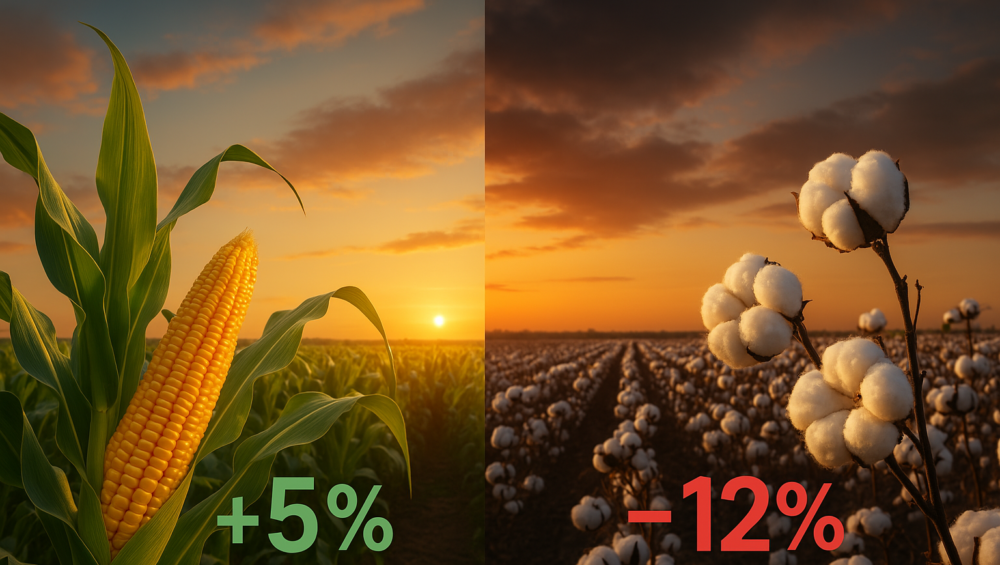A Quick Look at Recent US Ag Export Sales
Share This Story, Choose Your Platform!
Checking the weekly USDA export sales figures is always part of the routine for those keeping an eye on the ag markets. The latest numbers, covering the week ending April 24, 2025, offer a bit of an interesting snapshot.1 It’s just one week, naturally, but these figures give us a glimpse into current demand trends for key U.S. commodities.
What stands out in this particular report is a generally positive feel across the board for the big row crops. Net sales for the current marketing year saw an uptick compared to the previous week for corn, soybeans, wheat, and cotton.1 Seeing them all move in the same direction like that isn’t always the case, given their distinct markets, so it does catch the eye. It perhaps hints at some broader supportive factors during that specific period, maybe favorable currency movements or just solid global demand surfacing simultaneously. It’s certainly a welcome sign, though obviously just a single data point in a constantly shifting market.
Here’s a quick summary of the weekly net sales picture:
| Commodity | Net Sales (Week Ending Apr 24, 2025) | Change from Prior Week |
| Corn | ~1,512k MT | + ~336k MT |
| Soybeans | ~452k MT | + ~164k MT |
| All Wheat | ~202k MT | + ~106k MT |
| Upland Cotton* | ~117k RB* | + ~8k RB* |
| Metric Tons (MT) | ||
| Running Bales (RB) |
Source: USDA FAS Export Sales Data 1
Looking closer, corn put up some strong numbers. Net sales came in around 1.5 million metric tons ($1512.1$k MT), which was a noticeable jump of about 336,000 metric tons ($335.7$k MT) from the week before.1 That increase was the largest among these four commodities in terms of sheer volume. When you also consider the accumulated exports for the marketing year are already substantial, sitting around 41.8 million metric tons ($41783.4$k MT), it suggests a fairly healthy pace overall.1 These large accumulated figures mean a good chunk of the expected yearly total is already shipped, placing more focus on these ongoing weekly sales numbers as indicators of continued momentum.
Soybeans also showed positive movement. Net sales were reported at roughly 452,000 metric tons ($451.9$k MT), an increase of about 164,000 metric tons ($163.8$k MT) from the prior week.1 Similar to corn, accumulated soybean exports are quite high for the marketing year, tallying around 43.3 million metric tons ($43279.6$k MT).1
Wheat wasn’t left behind either, posting net sales of about 202,000 metric tons ($201.8$k MT), which represented an increase of approximately 106,000 metric tons ($105.7$k MT) week-over-week.1 Accumulated exports for wheat reached about 18.6 million metric tons ($18565.5$k MT).1
Then there’s cotton. The numbers here also showed an increase, with net sales of Upland cotton around 117,000 running bales ($117.1$k RB), up about 8,000 bales ($8.2$k RB) from the previous week.1 It’s always worth remembering that cotton export sales are reported in these “running bales,” which can be a bit tricky because, unlike the standard statistical bale (often 480 lbs), a running bale doesn’t have a single fixed weight – it typically varies.2 USDA uses certain assumptions to make conversions for broader balance sheets, but the raw sales data comes in this unit.2 Accumulated exports for Upland cotton stand at about 7.7 million running bales ($7747.4$k RB).1 The relatively smaller scale of the weekly increase here compared to the grains might just reflect the different cycles and demand drivers within the global textile industry.
So, the takeaway from this specific week ending April 24th seems to be one of broad, if modest, positive momentum in new sales for these major US agricultural exports.1 Of course, one week doesn’t make a trend, and the global market remains complex. It will be interesting to see if this pattern holds in the coming reports. It’s always something to watch in the export markets.
Share This Story, Choose Your Platform!
A Quick Look at Recent US Ag Export Sales
Share This Story, Choose Your Platform
Checking the weekly USDA export sales figures is always part of the routine for those keeping an eye on the ag markets. The latest numbers, covering the week ending April 24, 2025, offer a bit of an interesting snapshot.1 It’s just one week, naturally, but these figures give us a glimpse into current demand trends for key U.S. commodities.
What stands out in this particular report is a generally positive feel across the board for the big row crops. Net sales for the current marketing year saw an uptick compared to the previous week for corn, soybeans, wheat, and cotton.1 Seeing them all move in the same direction like that isn’t always the case, given their distinct markets, so it does catch the eye. It perhaps hints at some broader supportive factors during that specific period, maybe favorable currency movements or just solid global demand surfacing simultaneously. It’s certainly a welcome sign, though obviously just a single data point in a constantly shifting market.
Here’s a quick summary of the weekly net sales picture:
| Commodity | Net Sales (Week Ending Apr 24, 2025) | Change from Prior Week |
| Corn | ~1,512k MT | + ~336k MT |
| Soybeans | ~452k MT | + ~164k MT |
| All Wheat | ~202k MT | + ~106k MT |
| Upland Cotton* | ~117k RB* | + ~8k RB* |
| Metric Tons (MT) | ||
| Running Bales (RB) |
Source: USDA FAS Export Sales Data 1
Looking closer, corn put up some strong numbers. Net sales came in around 1.5 million metric tons ($1512.1$k MT), which was a noticeable jump of about 336,000 metric tons ($335.7$k MT) from the week before.1 That increase was the largest among these four commodities in terms of sheer volume. When you also consider the accumulated exports for the marketing year are already substantial, sitting around 41.8 million metric tons ($41783.4$k MT), it suggests a fairly healthy pace overall.1 These large accumulated figures mean a good chunk of the expected yearly total is already shipped, placing more focus on these ongoing weekly sales numbers as indicators of continued momentum.
Soybeans also showed positive movement. Net sales were reported at roughly 452,000 metric tons ($451.9$k MT), an increase of about 164,000 metric tons ($163.8$k MT) from the prior week.1 Similar to corn, accumulated soybean exports are quite high for the marketing year, tallying around 43.3 million metric tons ($43279.6$k MT).1
Wheat wasn’t left behind either, posting net sales of about 202,000 metric tons ($201.8$k MT), which represented an increase of approximately 106,000 metric tons ($105.7$k MT) week-over-week.1 Accumulated exports for wheat reached about 18.6 million metric tons ($18565.5$k MT).1
Then there’s cotton. The numbers here also showed an increase, with net sales of Upland cotton around 117,000 running bales ($117.1$k RB), up about 8,000 bales ($8.2$k RB) from the previous week.1 It’s always worth remembering that cotton export sales are reported in these “running bales,” which can be a bit tricky because, unlike the standard statistical bale (often 480 lbs), a running bale doesn’t have a single fixed weight – it typically varies.2 USDA uses certain assumptions to make conversions for broader balance sheets, but the raw sales data comes in this unit.2 Accumulated exports for Upland cotton stand at about 7.7 million running bales ($7747.4$k RB).1 The relatively smaller scale of the weekly increase here compared to the grains might just reflect the different cycles and demand drivers within the global textile industry.
So, the takeaway from this specific week ending April 24th seems to be one of broad, if modest, positive momentum in new sales for these major US agricultural exports.1 Of course, one week doesn’t make a trend, and the global market remains complex. It will be interesting to see if this pattern holds in the coming reports. It’s always something to watch in the export markets.
Share This Story, Choose Your Platform!
A Quick Look at Recent US Ag Export Sales
Share This Story, Choose Your Platform
Checking the weekly USDA export sales figures is always part of the routine for those keeping an eye on the ag markets. The latest numbers, covering the week ending April 24, 2025, offer a bit of an interesting snapshot.1 It’s just one week, naturally, but these figures give us a glimpse into current demand trends for key U.S. commodities.
What stands out in this particular report is a generally positive feel across the board for the big row crops. Net sales for the current marketing year saw an uptick compared to the previous week for corn, soybeans, wheat, and cotton.1 Seeing them all move in the same direction like that isn’t always the case, given their distinct markets, so it does catch the eye. It perhaps hints at some broader supportive factors during that specific period, maybe favorable currency movements or just solid global demand surfacing simultaneously. It’s certainly a welcome sign, though obviously just a single data point in a constantly shifting market.
Here’s a quick summary of the weekly net sales picture:
| Commodity | Net Sales (Week Ending Apr 24, 2025) | Change from Prior Week |
| Corn | ~1,512k MT | + ~336k MT |
| Soybeans | ~452k MT | + ~164k MT |
| All Wheat | ~202k MT | + ~106k MT |
| Upland Cotton* | ~117k RB* | + ~8k RB* |
| Metric Tons (MT) | ||
| Running Bales (RB) |
Source: USDA FAS Export Sales Data 1
Looking closer, corn put up some strong numbers. Net sales came in around 1.5 million metric tons ($1512.1$k MT), which was a noticeable jump of about 336,000 metric tons ($335.7$k MT) from the week before.1 That increase was the largest among these four commodities in terms of sheer volume. When you also consider the accumulated exports for the marketing year are already substantial, sitting around 41.8 million metric tons ($41783.4$k MT), it suggests a fairly healthy pace overall.1 These large accumulated figures mean a good chunk of the expected yearly total is already shipped, placing more focus on these ongoing weekly sales numbers as indicators of continued momentum.
Soybeans also showed positive movement. Net sales were reported at roughly 452,000 metric tons ($451.9$k MT), an increase of about 164,000 metric tons ($163.8$k MT) from the prior week.1 Similar to corn, accumulated soybean exports are quite high for the marketing year, tallying around 43.3 million metric tons ($43279.6$k MT).1
Wheat wasn’t left behind either, posting net sales of about 202,000 metric tons ($201.8$k MT), which represented an increase of approximately 106,000 metric tons ($105.7$k MT) week-over-week.1 Accumulated exports for wheat reached about 18.6 million metric tons ($18565.5$k MT).1
Then there’s cotton. The numbers here also showed an increase, with net sales of Upland cotton around 117,000 running bales ($117.1$k RB), up about 8,000 bales ($8.2$k RB) from the previous week.1 It’s always worth remembering that cotton export sales are reported in these “running bales,” which can be a bit tricky because, unlike the standard statistical bale (often 480 lbs), a running bale doesn’t have a single fixed weight – it typically varies.2 USDA uses certain assumptions to make conversions for broader balance sheets, but the raw sales data comes in this unit.2 Accumulated exports for Upland cotton stand at about 7.7 million running bales ($7747.4$k RB).1 The relatively smaller scale of the weekly increase here compared to the grains might just reflect the different cycles and demand drivers within the global textile industry.
So, the takeaway from this specific week ending April 24th seems to be one of broad, if modest, positive momentum in new sales for these major US agricultural exports.1 Of course, one week doesn’t make a trend, and the global market remains complex. It will be interesting to see if this pattern holds in the coming reports. It’s always something to watch in the export markets.






